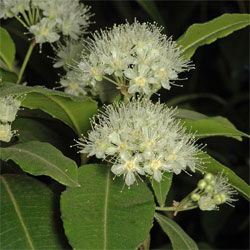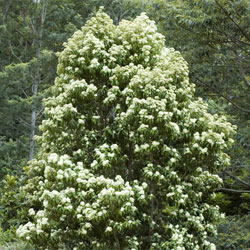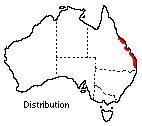Backhousia citriodora
 |
 |
Lemon Ironwood, Lemon-scented Myrtle
Backhousia citriodora F.Muell.
The genus Backhousia includes ten species, all of which are confined to the coastal rainforest areas of New South Wales and Queensland. Commonly referred to as 'myrtles' this group of plants, comprising trees and shrubs with strongly aromatic foliage, is included in the Myrtaceae family.
 Backhousia
citriodora occurs naturally in the Queensland coastal forests from Brisbane
to Mackay and is known by several vernacular names including Lemon Ironwood,
Lemon-scented Myrtle and Sweet Verbena Tree. It is a medium-sized shrub or tree,
to 8 m tall with a low-branching habit. Often in cultivation small branches
take root where they touch the ground. These branches are easily severed and
replanted.
Backhousia
citriodora occurs naturally in the Queensland coastal forests from Brisbane
to Mackay and is known by several vernacular names including Lemon Ironwood,
Lemon-scented Myrtle and Sweet Verbena Tree. It is a medium-sized shrub or tree,
to 8 m tall with a low-branching habit. Often in cultivation small branches
take root where they touch the ground. These branches are easily severed and
replanted.
The leaves of B. citriodora are a fresh green colour and strongly lemon-scented. They are attractively veined and oval or lance-shaped in outline, 50 -100 mm long with slightly toothed margins and a pointed apex. The young foliage is reddish and the young shoots and undersides of the leaves are often hairy.
The very attractive white flowers are numerous and produced in long-stalked clusters. The outer part of an individual flower consists of a bell-shaped hairy receptacle with 5 persistent spreading calyx lobes. These are surmounted by 5 small petals about 5 mm long and numerous fluffy stamens which are twice as long as the petals.
The fruit is a nut-like capsule which contains several small seeds. These are occasionally released but are generally retained until the whole fruit fails from the tree. B. citriodora is slightly frost-tender when young but can be grown outside in frosty areas provided it is planted in a sheltered position in semi-shade. Several specimens are thriving in the Australian National Botanic Gardens in the Rainforest Gully where some protection is provided by the tree canopy and surrounding shrubbery. Temperatures as low as -8ºC have been recorded in this section of the Gardens during winter.
The best method of propagation is from tip cuttings taken in March. Roots will develop much more effectively if the bases of the cuttings are dipped in a rooting hormone. The soil for planting should be rich, moist, well mulched and well composted.
Backhousia citriodora has great potential for use in domestic gardens for its aesthetic value and fragrance. It is easily maintained and in addition can be used as a container plant for indoors.
Text by Effie Mullins, ANBG (1989)
Name meaning: Backhousia citriodoraBackhousia - after James Backhouse, nurseryman, plant collector and Quaker missionary, citriodora - lemon-scented. |
![An Australian Government Initiative [logo]](/images/austgovt_brown_90px.gif)

